

© Shipping Wonders of the World 2012-

Floating Aerodromes
This chapter discusses the evolution of the aircraft carrier, which, although it has been a unit of the Royal Navy for more than twenty years, is still an experiment
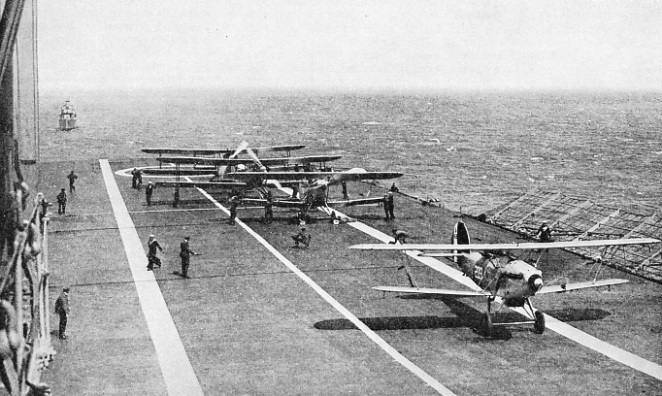
READY TO TAKE OFF from the flight deck of H.M.S. Courageous. Machines detailed for flying are brought up from their hangars by lifts and placed one behind the other. The ship’s head is then put into the wind and her speed considerably increased. The nets seen at the side of the deck are for the use of the personnel when the ‘planes take off or alight. H.M.S. Courageous was built in 1915 as a cruiser under the Emergency War Programme. Her conversion to an aircraft carrier was carried out between 1928-
THE term “aircraft carrier” is a convenient if somewhat inadequate label for a ship that is a mobile floating aerodrome, self-
Great Britain has always been the pioneer in the development of the aircraft-
On the outbreak of war the old cruiser Hermes and six cross-
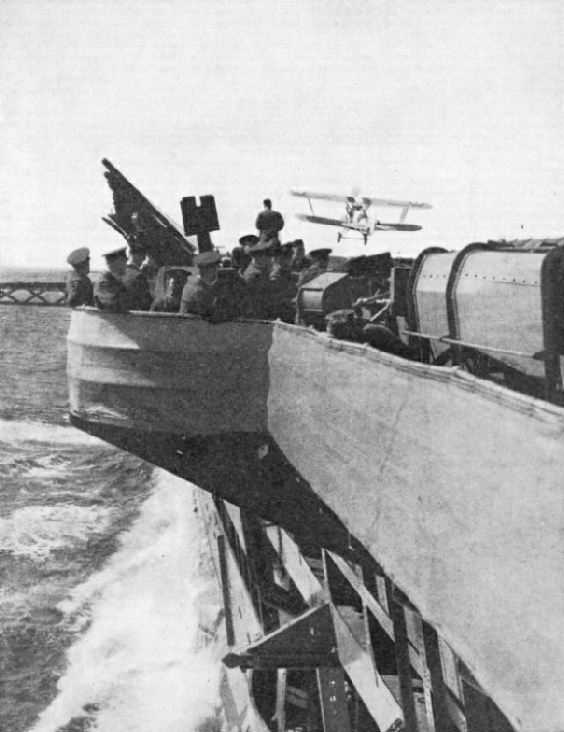
PERSONNEL OF THE ROYAL AIR FORCE, in HMS Furious. A Wing Commander is responsible, under the captain of the ship, for all flying work in an aircraft carrier. Each plane is constantly in touch by wireless telegraphy with the ship and with the leading machine of its squadron. When a flight is finished the carrier is steamed at very high speed, and from a point high up in the bows a jet of white vapour is poured out. The ship’s helm is moved until the vapour streams down the deck in line with the white painted band running fore and aft. A pilot then knows that the ship is running dead into the wind, and, at a signal from the Wing Commander, lands his plane on the stern of the carrier.
By this time the superiority of aeroplanes over seaplanes had been demonstrated, but there remained the problem of providing “landing-
Similar in general design are the Courageous and the Glorious, which were converted from cruisers to aircraft-
The other carriers are the Eagle, originally laid down as a Chilean battleship; the Argus, a converted merchantman, and the Hermes, until recently the only British carrier to be originally designed as such. A new ship, the Ark Royal, of 22,000 tons, was begun in the autumn of 1935. Leading particulars of the Navy’s aircraft-

The Royal Australian Navy has a seaplane carrier, the Albatross, a ship of 4,800 tons and 21 knots. She has an outfit of nine seaplanes which are launched by catapault, but as there is no flying-
The armament of the Royal Navy’s carriers is varied. It ranges from six 4-
The carrier, of course, is not meant to fight other ships, and her armament is purely defensive. Because of her high sides and broad expanse of flight deck she offers a tempting and extremely vulnerable target. A few shells or bombs blowing craters in the flight deck might render all flying impossible; other elements of great danger are the petrol tanks, the bomb-
When crowded with aircraft these hangars contain much inflammable material, and even in normal times elaborate precautions against fire have to be taken. Thus the aircraft-
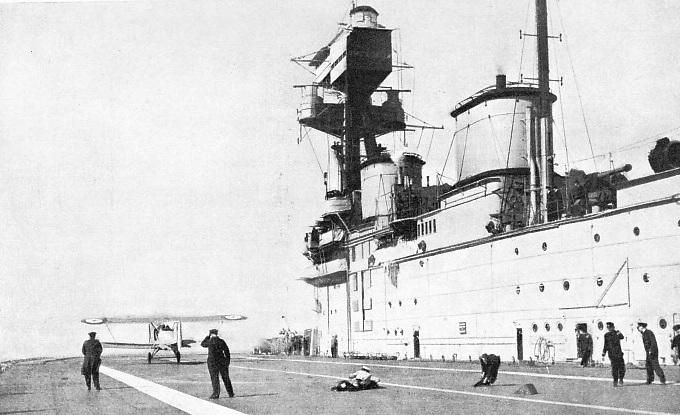
THE FLIGHT DECK OF H.M.S. EAGLE, showing the bridge and funnel on the extreme starboard side. H.M.S. Eagle was designed and her construction begun by Armstrong-
Before describing a typical carrier of the Royal Navy we must consider two of the American Navy’s vessels of this type, the Saratoga and the Lexington. Begun in 1920-
Either ship can accommodate from eighty to ninety aircraft, and the total complement, including aviation personnel, is 1,899, a record number for a man-
The following description of a British carrier and how she goes to work is based on personal observations during a cruise in H.M.S. Furious. Because of her singular appearance this ship is generally referred to by naval wits as “Noah’s Ark” or “the Covered Wagon”. Above the hull proper the high sides are flared out to give additional width to the flight deck, 75 feet above the water. For half its length the deck is fenced with palisades, to prevent aircraft skidding overboard. Deep nets are fitted on either side to safeguard the personnel. A broad band of white paint runs fore and aft, exactly in the centreline. At the extreme forward end of the deck is a telescopic bridge and control station, lowered, when necessary, until its top is flush with the deck. In this structure the captain and the senior flying officer take up their posts when flying operations are in progress.
Going below, one is impressed by the enormous size of the hangars, which are about 18 feet high, 60 feet wide, and from 400 to 500 feet long. As petrol gas is always present they are treated as dangerous spaces. Fixed bulkheads being impracticable, the hangars are partitioned off by steel roller fire curtains worked by electro-
To operate a large number of aircraft it is obviously necessary to carry a considerable quantity of aviation spirit. This is stored in cylinders in the hold at either end of the ship, with pipes leading to fuelling points in the hangars and on the flight deck. The cylinders are so arranged that they can be dumped overboard and sunk at the first sign of any real danger. On the forward end of the flight deck large transverse wind screens are fitted to provide a shelter in the lee of which aircraft can be finally tuned up before taking off. When not in use the screen’s fold into recesses in the deck and offer no obstruction. The lifts used for carrying aircraft from the hangars to the flight deck, or vice versa, are about 50 feet wide and 45 feet long, and are large enough to take machines with their wings spread. In the latest carriers these lifts move at comparatively high speeds.
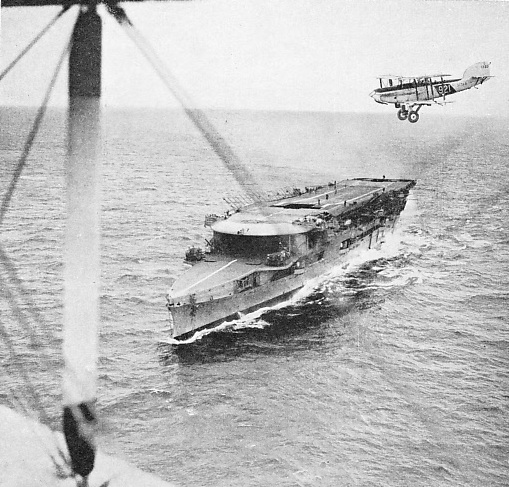 ALTHOUGH SEVERAL SHIPS WERE CONVERTED TO AIRCRAFT CARRIERS, H.M.S. Furious was the first genuine floating aerodrome. Built under the Emergency War Programme, H.M.S. Furious was begun as a cruiser in June, 1915, and completed in July, 1917. She was rebuilt in November, 1917, as an aircraft carrier, and again in 1918. Since then further alterations have been made, her mast having been removed and her funnel suppressed, so that boiler-
ALTHOUGH SEVERAL SHIPS WERE CONVERTED TO AIRCRAFT CARRIERS, H.M.S. Furious was the first genuine floating aerodrome. Built under the Emergency War Programme, H.M.S. Furious was begun as a cruiser in June, 1915, and completed in July, 1917. She was rebuilt in November, 1917, as an aircraft carrier, and again in 1918. Since then further alterations have been made, her mast having been removed and her funnel suppressed, so that boiler-
In the early days special gear was fitted to the deck to check the momentum of machines when landing and bring them to a standstill. It consisted of transverse wires engaged by hooks on the under-
For a time, therefore, it was abandoned in favour of the simpler method of man-
When a carrier’s aircraft are ordered to take the air the machines detailed for flight are brought up on deck by the lifts and “parked” one behind the other in two or more lines. The engines are then started up and left running for several minutes. Pilots and observers climb into their places, and mechanics make a last-
Spectacular Landings
One by one the other ‘planes follow, and in a surprisingly short space of time a score or more of “fighters”, “spotter reconnaissance”, and “torpedo bomber” machines are aloft. They may be “spotting” for the big guns of the battleships at long-
When the flight comes to an end, the really spectacular part of the operation begins. The ship is steamed at very high speed and from a point well up in the bows a jet of white vapour is poured out. The ship’s helm is moved until the vapour streams down the deck exactly in line with the white-
The Wing Commander signals the leading ‘plane to land. Executing a perfect circle the pilot brings his machine down to the level of the ship’s stern and an instant later his wheels mount the overhanging ramp and run along the deck, where the arresting gear comes into action and deck parties take charge. The ‘plane is then run forward along the deck to the nearest lift, which immediately descends. In the brief time the ‘plane takes to reach the hangar the wings have been folded back and the machine is wheeled to its place in the hangar, while the lift goes up to receive the second machine, which has already landed.
Landing becomes a more complicated affair when the sea is rough and the carrier shows a tendency to roll or pitch, or to do both. Such occasions call for consummate judgment on the part of the pilot, who must choose the exact moment to land when deck and machine are level.
When flying is in progress a carrier must be escorted by two destroyers, which keep station on her starboard and port quarter respectively and follow all her movements. As the destroyers are under a full head of steam they can dash off to the rescue at once should an aeroplane fall into the sea.
The Fleet Air Arm has not only come to stay but also it is assured of far-
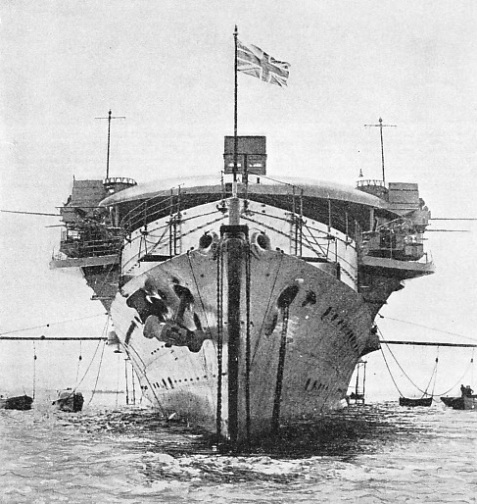
BECAUSE OF HER ODD APPEARANCE, H.M.S. FURIOUS is often referred to as “Noah's Ark” or “the Covered Wagon”. Above the hull proper her sides are flared out to give additional width to the flight deck, 75 feet above the water. For half its length the flight deck is fenced with palisades to prevent aircraft skidding overboard. At the extreme forward end can be seen the telescopic bridge and control station, which can be lowered until its top is flush with the deck. In this structure the captain and senior flying officer take up their posts when flying is in progress.
You can read more on “The Navy Goes to Work”, “Navy Week” and “The United States Navy” on this website.
You can read more on “The Fleet Air Arm” in Wonders of World Aviation